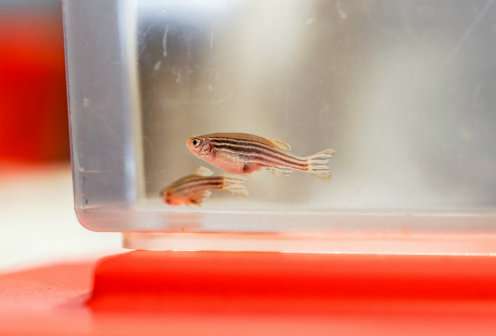Defect in cellular sensory cilia linked to deformed organs in zebrafish

A protein at the base of the 'antenna' of many of the body's cells is vital to a crucial type of cell signal and to whether organs like the heart develop correctly, a test with zebrafish shows. The test is part of a new study conducted by researchers from the University of Copenhagen and the University of Southern Denmark.
Cells in eukaryotes have sensory cilia that receive signals from the cell's surroundings like antennae. Researchers have now discovered a protein, CEP128, at the base of the antenna, that regulates the antenna's ability to translate specific signals inside the cell. The protein appears to be crucial to the development of vital organs in the body. In a new study published in the scientific journal Cell Reports, a team of researchers from the University of Copenhagen and the University of Southern Denmark shows that if the gene coding for this protein is inactive, it causes severe malformations in zebrafish.
"We knew that something in the cells' antennae regulated these cell signals. But we now know that this protein plays a main role in balancing the signal in such a way that the organs during the body's earliest stage of development develop correctly—at least in zebrafish, where inactivity of the gene leads to severe malformations of the heart, among other things," says Professor Lars Allan Larsen from the Department of Cellular and Molecular Medicine.
The researcher report that the so-called TGF-beta signalling is regulated by the protein. This signalling controls a series of critical cellular processes in the body, both during the development of the foetus and in adult life.
The researchers hope that more knowledge of cell signalling may ultimately lead to treatments preventing cells during foetal development from behaving incorrectly, causing malformations of the heart and other vital organs. They have not come this far yet, though, and so far they are trying to learn more about the cellular mechanisms behind the signalling.
In the new study, the researchers also demonstrated the effect in human cells. They have examined the significance of the protein to cell cultures and discovered that a lack of CEP128 causes poor signalling in the cilium, as in zebrafish. It is well-known that defects in the cells' antennae can cause birth defects and diseases in adulthood, and new knowledge of the causes of these conditions is therefore important for the development of new forms of treatment for patients with cell antenna defects.
"This study is a good example of what we can achieve through cross-disciplinary cooperation. None of the three research groups would have had the facilities or expertise to succeed with this research alone," says Lotte Bang Pedersen, who expects the group to make new discoveries about the function of cell antennas in a similar way in the future.
More information: Maren Mönnich et al, CEP128 Localizes to the Subdistal Appendages of the Mother Centriole and Regulates TGF-β/BMP Signaling at the Primary Cilium, Cell Reports (2018). DOI: 10.1016/j.celrep.2018.02.043
Journal information: Cell Reports
Provided by University of Copenhagen



















